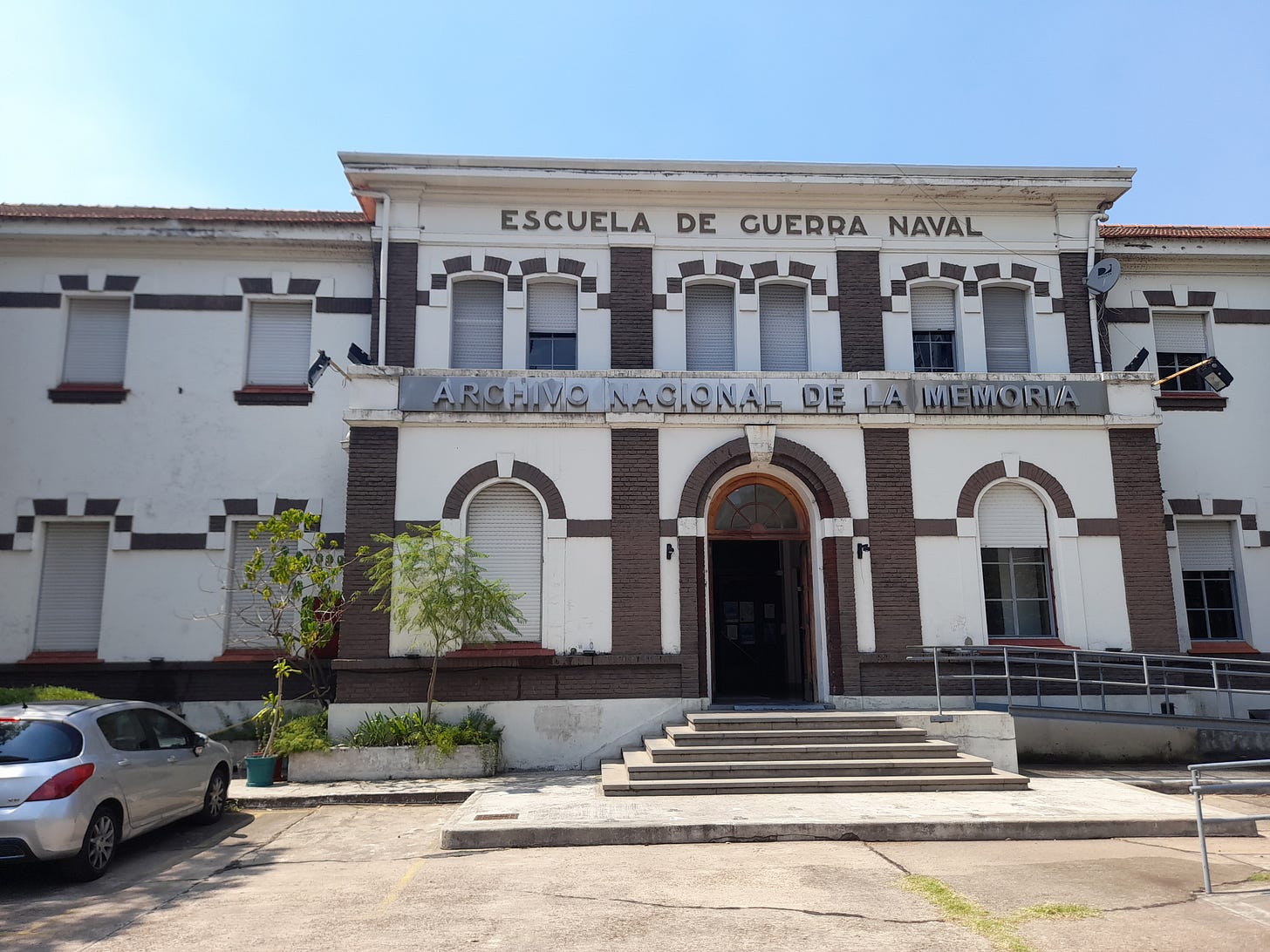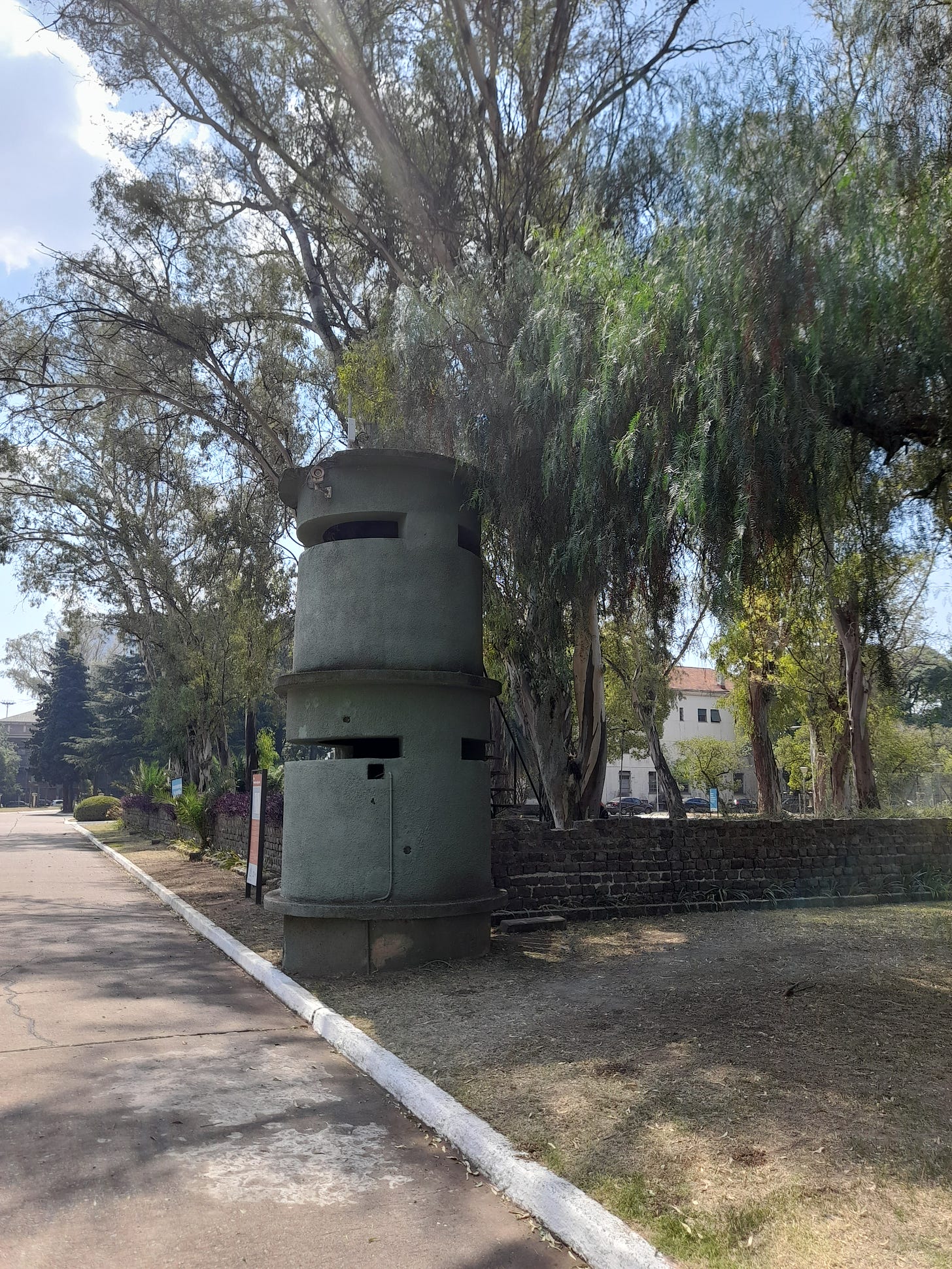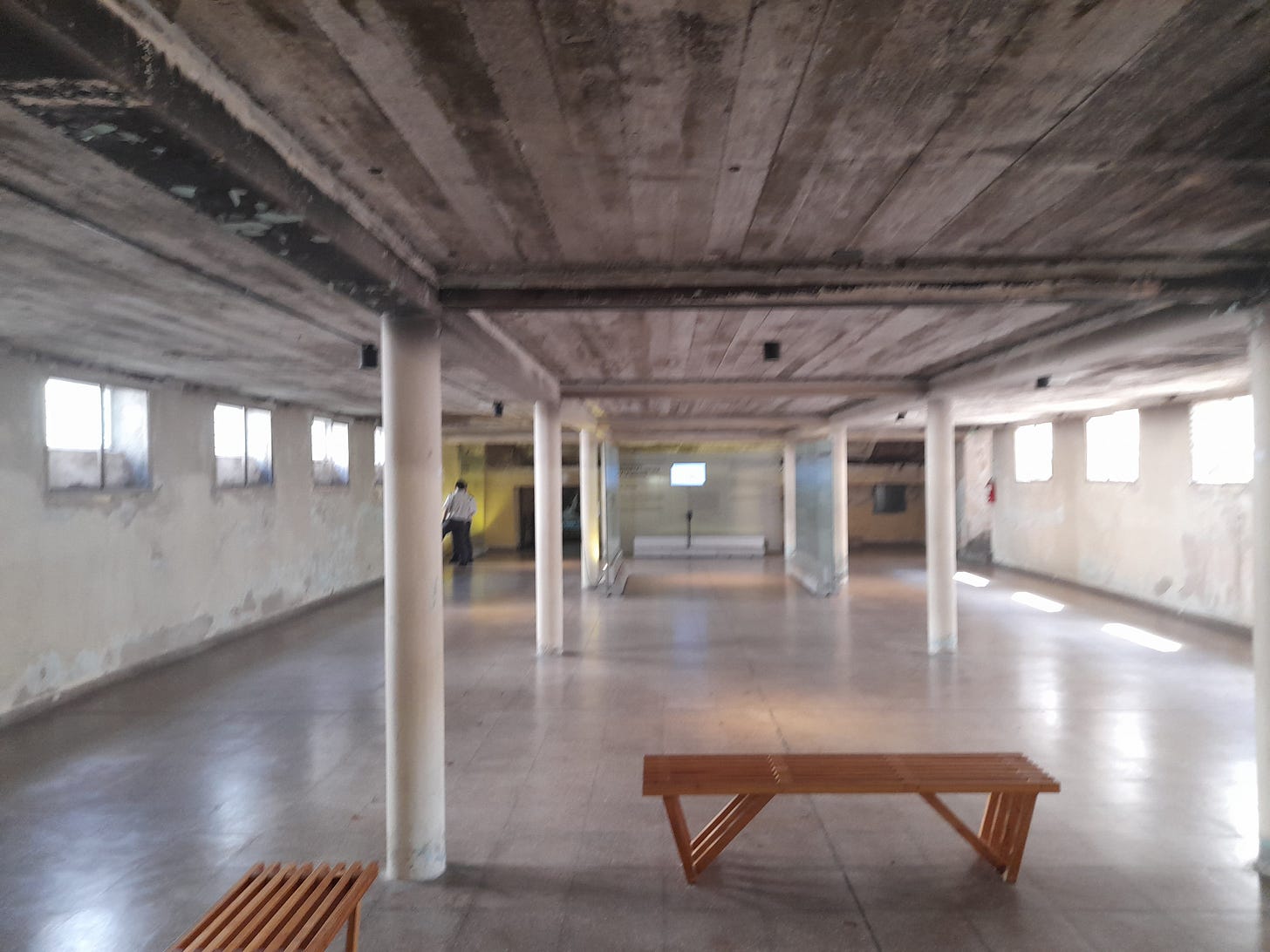I’ve been in Argentina for two weeks now, and I’ve still got six weeks to go, so expect a few dispatches with an Argentinian/Patagonian/Chilean focus and flavour as I make my way southwards to Tierra del Fuego and back up to Buenos Aires.
One of the components of the book I’m compiling concerns museums, with an emphasis on the way that countries with ‘difficult’ histories remember or fail to remember the darker episodes in their past.
Argentina, as many readers will know, has had some very dark episodes to deal with, of which the most sinister and well-known is the 1976-1983 military dictatorship. I first wrote about the so-called ‘guerra sucia’ - dirty war - or ‘Process of National Reorganisation’, as the Argentine generals put it, in my book The Infernal Machine: An Alternative History of Terrorism.
This ‘war’ has come under new international scrutiny recently, as a result of the Oscar-nominated Argentina, 1985, and the documentary El Juicio (the trial). As a result of the former film in particular, audiences who know little about Argentine history have become familiar with the secret program of torture and mass murder waged by the Argentine security services against a plethora of leftwing ‘urban guerrilla’ groups, and anyone else perceived to be a critic of the regime. An estimated 30,000 people were murdered and/or ‘disappeared’ during the ‘Process of National Reorganisation’, as the military called it, in one of the cruellest and most pitiless programs of state terror ever in history.
The epicentre of this lawless machinery of extermination was a cluster of posh white buildings known as the Escuela Mecánica de la Armada (Navy Mechanical School), known as the ESMA. Originally created just after World War I as a technical training and passing out centre for Argentine naval officers, the ESMA became the most prolific of all the Argentine military’s secret archipelago of torture and murder centres.
Some 5,000 people were tortured and detained here before being ‘transferred’ - a euphemism for execution that could include being drugged and thrown in batches and thrown from helicopters, or shot and buried in a clandestine grave. Today the ESMA is a museum and a ‘Space of Memory and Human Rights.’
Photographs of the men and women - most of them young - who were taken there, cover a glass wall leading to the officers’ casino where detainees were ‘sucked up’. Their faces stare back from display boards in the gardens, accompanied by brief but moving biographies. Most of them are young, and whatever their political affiliations, none of them deserved the awful treatment meted out by a regime that regarded them as ‘enemies of Western civilisation’ who had lost their right to be treated as human beings.
I knew about the ESMA from my previous readings. I knew pregnant women were kept there until their babies were delivered, after which their mothers were ‘transferred.’ I knew that Admiral Emilio Massera - a genuinely evil insult to humanity with a penchant for murder and pompous pseudo-intellectual pontification - organized a ‘press unit’ inside the ESMA, in which the prisoners his officers had tortured were forced to churn out political propaganda in order to live a little longer.
I knew that Alfredo Astiz, the naval officer known as the ‘Blond Angel of Death’ was a member of an ESMA task force when he shot a young Swedish girl in the back during a botched raid before taking her back to the ESMA, where she was killed in order to avoid embarrassment. Astiz and infiltrated the Mothers of the Plaza de Mayo and subsequently kidnapped 12 people connected with the group, including two French nuns who were taken to the ESMA and never seen again.
Nevertheless it was a sombre and dispiriting experience to wonder through the pristine white stone buildings, and contemplate the actual physical spaces where these atrocities had occurred. The ESMA is located in an upmarket district of Buenos Aires on the Avenida del Libertador, just up the road from the hockey pitches and sports facilities of the Club Ciudad de Buenos Aires.
On a searingly hot autumn morning, the white buildings looked dazzling and pristine, and apart from the sentry towers where the task forces had to give the password when they came back at night with their hooded prisoners, there is no obvious sign that the complex ever had a military purpose, let alone that the actual purposes to which it was put during the dictatorship.
The museum has gone to some lengths to explain exactly what it was used for. You can see the little room where pregnant women were kept in chains, waiting to give birth, after which they were killed. You can seen the room where navy officers played billiards, Andy the basement where prisoners were injected with tranquilisers before being taken out naked to helicopters or planes.
A young museum attendant guided us to the attic where detainees were kept hooded for months and even years, where a guard once allowed prisoners to take off their hoods for King’s Night. For a few hours the prisoners laughed, joked and talked about the King’s Nights they remembered from their childhood before the hoods were returned.
Such small gestures of humanity were rare at the ESMA. We saw the car park where the task forces parked the Ford Falcons they used to ‘chupar’ (suck up) their victims. A glass plaque bears the journalist and Montonero activist Rodolfo Walsh’s famous 1977 letter denouncing the crimes of the regime, which was sent out across the world, a desperate message in a bottle which only intensified the military’s determination to kill the man responsible.
In 27 March 1977 Walsh was cut down in a hail of machine gun fire, gun in hand, when a task force caught him posting letters in Buenos Aires, not far from the district where his daughter Vicky - also a Montonera - had shot herself six months earlier rather than surrender to the soldiers who surrounded their safe house.
Had they been captured, Walsh and his daughter would have ended up here, in the former officers’ casino where prisoners were tortured and sent to their deaths. It’s startling to see how close these facilities were to the sleeping quarters and offices of the task force commanders who presided over this machinery of extermination.
The director of the ESMA, Admiral Rubén Chamorro, even had his family home next in some rooms in the casino. It’s about two minutes walk from the basement where prisoners were being tortured, to the parquet floors of the living quarters where Chamorro invited friends and relatives for barbecues at the weekends.
Such horrors strain credulity, just as Nazi concentration camps once tested the imaginations of those who entered and liberated their camps. The ESMA belongs to that same tradition of radical political evil, in which concentration camp officers can listen to classical music after a hard day’s work, and Auschwitz guards go on jolly group bonding weekends away to de-stress. At ESMA there was no liberation, and considering the scale of the crimes against humanity that took place there, very little punishment.
How could such things have happened? Why did a modern state that considered itself to be civilised and moral turn into Cronus and eat its young in the last decades of the twentieth century? Why do sordid, cowardly little murderers like Alfredo Astiz still insist that they were ‘defending the fatherland’ by killing nuns and teenagers? How could thousands of Argentine soldiers, naval officers and policemen have convinced themselves that it was legitimate and even necessary to annihilate an entire political generation?
The museum’s organisers have tried to answer these questions. You can watch taped extracts from the trials of the leading generals, and read quotes from detainees and former soldiers and naval officers, and an Argentinian cleric Catholic Church, who described throwing drugged prisoners out planes and helicopters as a ‘Christian’ way of eliminating the enemy according to the Bible.
It’s easy - and convenient - to attribute such acts to ‘Hispanic cruelty’, as the Cold War spook and ‘terrorism expert Brian Crozier once did. Argentine history is certainly not short on episodes of cruelty or injustice, whether in the civil wars that followed Independence, the regime of General Rosas, the wars waged against Argentina’s indigenous peoples or the massacres of Patagonian strikers and Chaco indigenous peoples in the 1920s.
But essentialising the Argentine people or Argentina as a nation doesn’t take us very far. It’s true that Argentina’s rulers, historically, have tended to respond to internal threats and political or social challenges from their underlings with extreme violence. It’s also true that the Argentinian armed forces - conveniently - conceptualised a fairly motley and occasional assembly of armed leftwing/Peronist guerrillas as a moral and civilisational ‘other.’
Algeria and the ‘French School’
The methods adopted by the dictatorship and put into practice at the ESMA were not Argentine inventions however. The Argentine generals took inspiration from the ‘French school’ of counterinsurgency doctrine, which supposedly ‘reverse engineered’ Maoist/Leninist concepts of revolutionary war, so that the whole of society became a battleground against an invisible communist enemy against whom all methods were legitimate.
In this ‘war’, torture was simultaneously a means of obtaining specific intelligence information, a punishment, and an unspoken ‘phantom terror’ that paralysed and cowed Argentine society into obedience and submission. Torture made it possible to unlock the connections that held underground revolutionary organisations. By executing them without trial and in secret, the state was able to destroy its enemies and critics without every being bound by legal or moral norms, and without even acknowledging responsibility.
This is what the ‘gentlemen of the sea’ who worked at the ESMA set out to do, with terrifying efficiency. I was intrigued to see a quote on one of the information boards at the ESMA from a former naval officer, who describes how he and his peers were shown The Battle of Algiers as part of their training before the dictatorship came to power, and told that they should emulate the methods used by French paratroopers in Algiers: secret detention/torture/disappearances, and official silence.
So much for ‘Hispanic’ cruelty. This particular officer refused, and was kicked out of the navy as a result. Many of his colleagues did not, and went on to refine the methods taught to them by the French, and fully imbibed the US ‘National Security Doctrine’, which placed ‘national security’ above all other concerns in its response the armed urban guerrilla groups and the social movements they were connected to.
Having convinced themselves that they were at war with an internal enemy linked to a vast international conspiracy, these officers granted themselves carte blanche. Of course, such doctrines are always going to be appealing to certain individuals. Many task force commanders, including Massera himself, made money by stealing the possessions of their victims and even selling their flats and houses - or their children.
A lot of the violence at the ESMA was gendered violence directed against women, which always took very particular forms, whether it was rape or the grotesque practice by which some torturers instructed their female prisoners on how to wear make up and took them out on ‘dates’. A touring exhibition on the treatment of women in the ESMA, organised in association with the InteramericanHuman Rights Commision is currently touring Latin and North America. It demonstrates once again that these noble Cold War who dirtied their hands in the name of the patria weren’t as noble as they claimed to be, whatever fantasies they used to justify their grotesque and monstrous acts.
They were rapists, sadists, and murderers, who abandoned their own humanity even as they denied humanity to others. And if the museum teaches us anything, it is that under certain conditions, for example, in the toxic hothouse of a fascistic regime consumed by hatred and paranoia, human beings can be made or persuaded to commit any crime required of them, and the darkness that is mostly submerged in everyday society can be brought to the surface and unleashed with terrifying consequences. When I was there, the museum was holding a temporary exhibition, looking at the similarities between the ESMA and Robben Island during apartheid. In the past it has held exhibitions making connections between the ‘disappeared’ and the treatment of Argentina’s indigenous peoples.
The museum also contains a cultural centre in honour of the murdered writer Haroldo Conti who was last seen in the ESMA. Here you can read texts from Conti and some of the Argentinian writers who tried to imagine a way out of the nightmare of their country’s history.
Most of the museum staff are as young as the ‘terrorists’ who were brought here to be murdered. They were friendly and engaging, and clearly proud of the work they were doing, like the young researchers in Argentina, 1985.
Their presence brings light and hope to this place of darkness, and points towards an Argentinian present that is already very different to the madness that engulfed their country in the 1970s. And so does the building named after the writer whose gentle, bespectacled face adorned its walls. Conti was ‘sucked up’ coming back from the cinema with his wife, and there was no better tribute to this writer who loved rivers and water, than to turn the institution that had killed him into in a space where visitors can listen to poetry and music, dance, meet and talk, and hold the conversations we all need to have, in whatever country we come from, if the brittle crust of civilisation is to be preserved, and humanity can go forward without slipping into barbarism.









Writing from Germany, I find this impressive and convinving.
Thanks Matt - thoughtful piece.